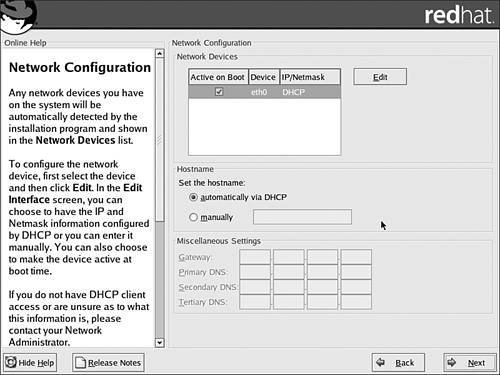Network Configuration
| The network configuration of the Linux computer really entails making a simple choice between configuring the server (or workstation, if that is what you are configuring) with a static IP address and other IP related settings, such as DNS servers and default gateway, or allowing the computer to receive its IP configuration from a DHCP server (see Chapter 12, "TCP/IP Network Administration," for more about TCP/IP administration and settings). For Red Hat, the default installation setting is to receive the TCP/IP configuration from a DHCP server, as shown in Figure 10.2. If you are going to configure the server with a static IP address and other settings, click the Configure Using DHCP check box to clear it and then provide the IP address, subnet mask, and other static settings for the computer (in the case of a server installation, you typically want to configure your server with static settings, especially if the server is going to provide services such as Web server). Figure 10.2. Select how the computer will be configured for IP networking. After completing the IP configuration settings for the server, the next installation step relates to configuring a firewall for the system. You can choose different security levels for the firewall (High, Medium, No firewall) and then specify the type of protocols that you will allow to pass through the firewall (such as WWW, FTP, and DHCP). For more about the basics related to firewalls, see Chapter 20, "A Network Security Primer." |
EAN: 2147483647
Pages: 188
